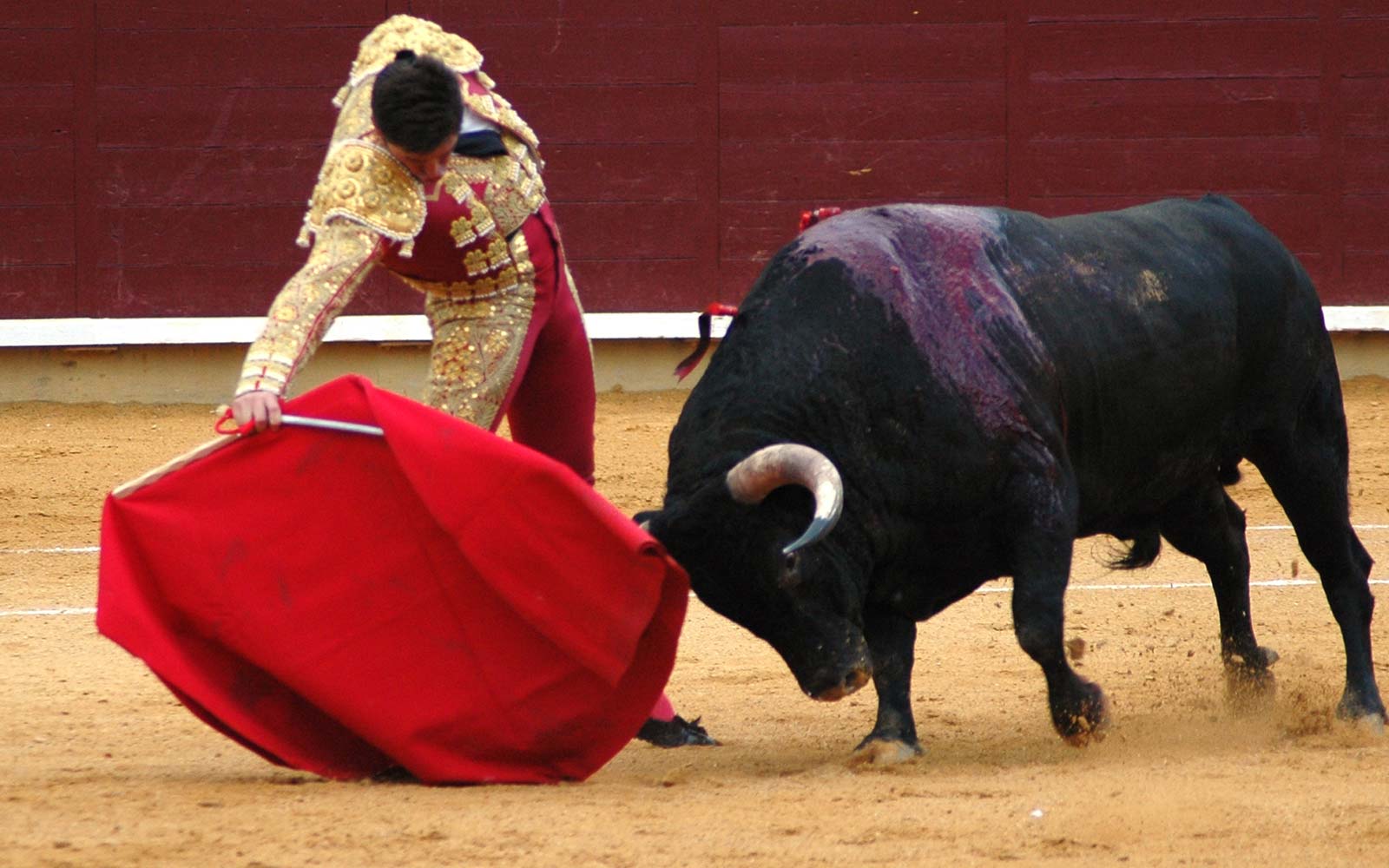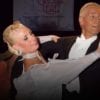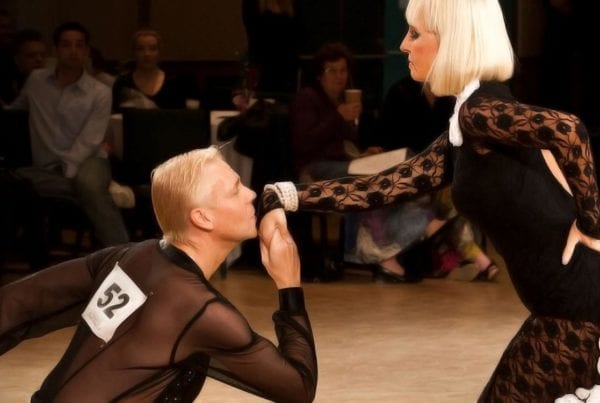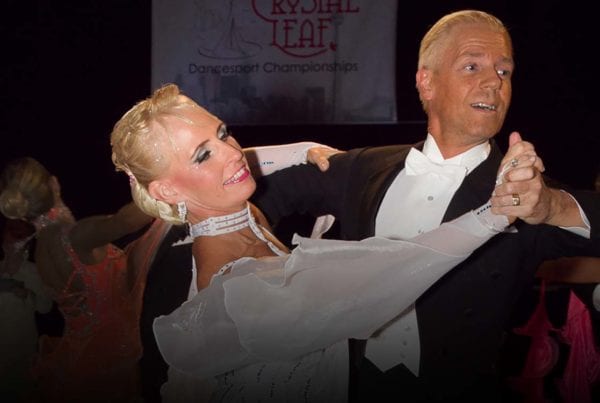I have always loved the Paso Doble. I loved watching it performed, but was not introduced to it in my own dancing until I was at Pre-Championship level as a competitive Latin dancer. It’s sad that so many dancers have to wait until they are already skilled before they are given access to this dance through typical training programs.
Fortunately, the coach we worked with to develop our open level choreography, Martin Lefebvre of Calgary, loved the Paso and gave us a solid foundation for this spectacular dance. He even brought a cape to the lessons so that he could help me fully grasp the characterization of different figures.
Paso Doble is the only dance in the Ballroom or Latin genres where characterization and emotional expression are more important than technical precision. Although Rumba also has a lot of emotional expression, much of the attention in Rumba is on technique such as the straightening of the legs and the timing of body position in relation to foot position. This kind of thinking isn’t really applied in the Paso. We like to see heels used for walks and we need to have our weight in the right place, but in general there is lot less than other dances in the way of technical detail.
Also, the Paso Doble is the only dance where the majority of attention is on the man. We refer to it as a man’s dance for that reason. The Tango also gives the man a fair amount of attention, but he still remains largely in the background, allowing the lady’s action to be more important throughout most of the dance. For example, in Tango we see the lady react to the lead for Promenade Links, but we really should not notice the lead being given. The man must lead strongly but in a way that it’s hardly even noticed. In the Paso, he is front and center throughout the dance, showing strength, confidence and yes, even arrogance.
Matadors who participated in bullfights were supremely arrogant. Their ability to face down a 1000 lb charging bull while remaining still and absolutely in control was legendary. This is largely characterized in the dance. Stillness is a vital element of a great Paso Doble performance. Movements must be clear and controlled throughout the dance.
Unlike other dances, the lady must keep her attention on the man at all times so that she can properly represent the cape. There is a kind of razor-sharp focus of both parties in their performance, just as the matador focuses on every emotion of the bull to anticipate its next move.
Another aspect that makes the Paso such an exciting dance to learn is that it allows a very precise story to be told through every figure. Each group of step patterns is clearly designed to express a particular element of the story. Grand Circle is clearly the picture of the matador swirling his cape around him. La Passe expresses the cape being flicked back and forth. Promenade Spins reflect a spinning cape. Coup de Pique is a representation of the final victory over the bull (don’t worry, no bulls are harmed in this dance!). Flamenco Taps, while having nothing to do with the cape or the bull, are an expression of the lady’s role and of the dynamics between the two partners.
It’s really a great deal of fun to perform this dance, especially with someone who understands those characterizations.
The matador in the bull ring is not only confident and brave, he is fully aware of everything around him. He is aware of his own posture, of his body, of his space. He is mentally strong. The lead in the dance must convey these same characteristics if he wishes to put on a believable performance.
There is a kind of razor-sharp focus of both parties in their performance, just as the matador focuses on every emotion of the bull to anticipate its next move.
One of the most entertaining visualizations of this character can be found in the motion picture “Book of Life,” which is about a matador hoping to honor the tradition of his family. In one scene, we see the story of the family line, showing how each generation of matadors met their fate by pushing their confidence just a little too far. It’s a very funny scene, and beautifully identifies this aspect of the character of a matador.
Everything a matador does is contrary to normal human behavior. When a bull charges towards you, the natural response would be to discover how fast you can run. The bullfighter stands still and actually draws the bull towards him, using his cape and body shape to trick the bull into missing his body by inches as he charges.
Matadors are masters of their movement. Every action has its place and they use these actions to perfection, sometimes soft and small, sometimes large and dramatic.
Lady just as important
The lady’s role in this dance is just as important as the man’s, even though he might be considered the star. She needs to be just as strong, but also fluid and soft, curving and flowing in response to his movements. In addition, she has a key role as the Flamenco Dancer. These dancers are incredibly strong, confident in their own sensuality, and full of wisdom. Like the matador, they are aware of every part of their body and use it to perfection, Even their fingers play a role in drawing the eye during the performance.
The lady is aware that this is a man’s dance, and supports that reality. She respects that. She enjoys his strength and confidence. She gives him the ability to take on this role and empowers it through her own actions. At the same time, she knows that the presence of a lady makes the dance work, so she understands her own role in the performance. While she doesn’t compete with him, she is equally as powerful and just as important in the overall story.
When describing the Tango, I like to say that the lady gives the man permission to be in control. She knows that ultimately her own sexuality controls him, but she gives herself to him to lead her actions and responses. The Paso Doble is no different. The lady knows that her partner would be limited in his performance, with no story to tell if he had no cape, yet she celebrates his role and supports it.
These are some of the reasons why I have always loved the Paso Doble. It isn’t particularly difficult to learn, but for many people — especially those who lack self-confidence — it can be challenging to overcome those internal barriers and embrace the dance. If you’re a social dancer, give this dance a try and you may find a new source of confidence as a performer.
You might also like “The Secret Ingredient to Paso Doble”










